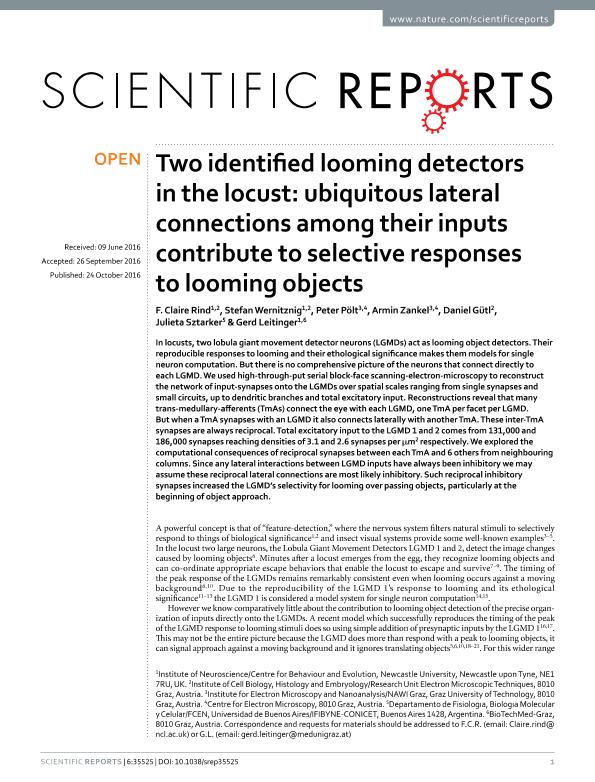Artículo
Two identified looming detectors in the locust: Ubiquitous lateral connections among their inputs contribute to selective responses to looming objects
Rind, F. Claire; Wernitznig, Stefan; Pölt, Peter; Zankel, Armin; Gütl, Daniel; Sztarker, Julieta ; Leitinger, Gerd
; Leitinger, Gerd
 ; Leitinger, Gerd
; Leitinger, Gerd
Fecha de publicación:
10/2016
Editorial:
Nature Publishing Group
Revista:
Scientific Reports
ISSN:
2045-2322
Idioma:
Inglés
Tipo de recurso:
Artículo publicado
Clasificación temática:
Resumen
In locusts, two lobula giant movement detector neurons (LGMDs) act as looming object detectors. Their reproducible responses to looming and their ethological significance makes them models for single neuron computation. But there is no comprehensive picture of the neurons that connect directly to each LGMD. We used high-through-put serial block-face scanning-electron-microscopy to reconstruct the network of input-synapses onto the LGMDs over spatial scales ranging from single synapses and small circuits, up to dendritic branches and total excitatory input. Reconstructions reveal that many trans-medullary-afferents (TmAs) connect the eye with each LGMD, one TmA per facet per LGMD. But when a TmA synapses with an LGMD it also connects laterally with another TmA. These inter-TmA synapses are always reciprocal. Total excitatory input to the LGMD 1 and 2 comes from 131,000 and 186,000 synapses reaching densities of 3.1 and 2.6 synapses per μm 2 respectively. We explored the computational consequences of reciprocal synapses between each TmA and 6 others from neighbouring columns. Since any lateral interactions between LGMD inputs have always been inhibitory we may assume these reciprocal lateral connections are most likely inhibitory. Such reciprocal inhibitory synapses increased the LGMD's selectivity for looming over passing objects, particularly at the beginning of object approach.
Palabras clave:
Colision Avoidance
,
Locust
,
Lgmd
,
Electron Microscopy
Archivos asociados
Licencia
Identificadores
Colecciones
Articulos(IFIBYNE)
Articulos de INST.DE FISIOL., BIOL.MOLECULAR Y NEUROCIENCIAS
Articulos de INST.DE FISIOL., BIOL.MOLECULAR Y NEUROCIENCIAS
Citación
Rind, F. Claire; Wernitznig, Stefan; Pölt, Peter; Zankel, Armin; Gütl, Daniel; et al.; Two identified looming detectors in the locust: Ubiquitous lateral connections among their inputs contribute to selective responses to looming objects; Nature Publishing Group; Scientific Reports; 6; 10-2016; 1-16
Compartir
Altmétricas



